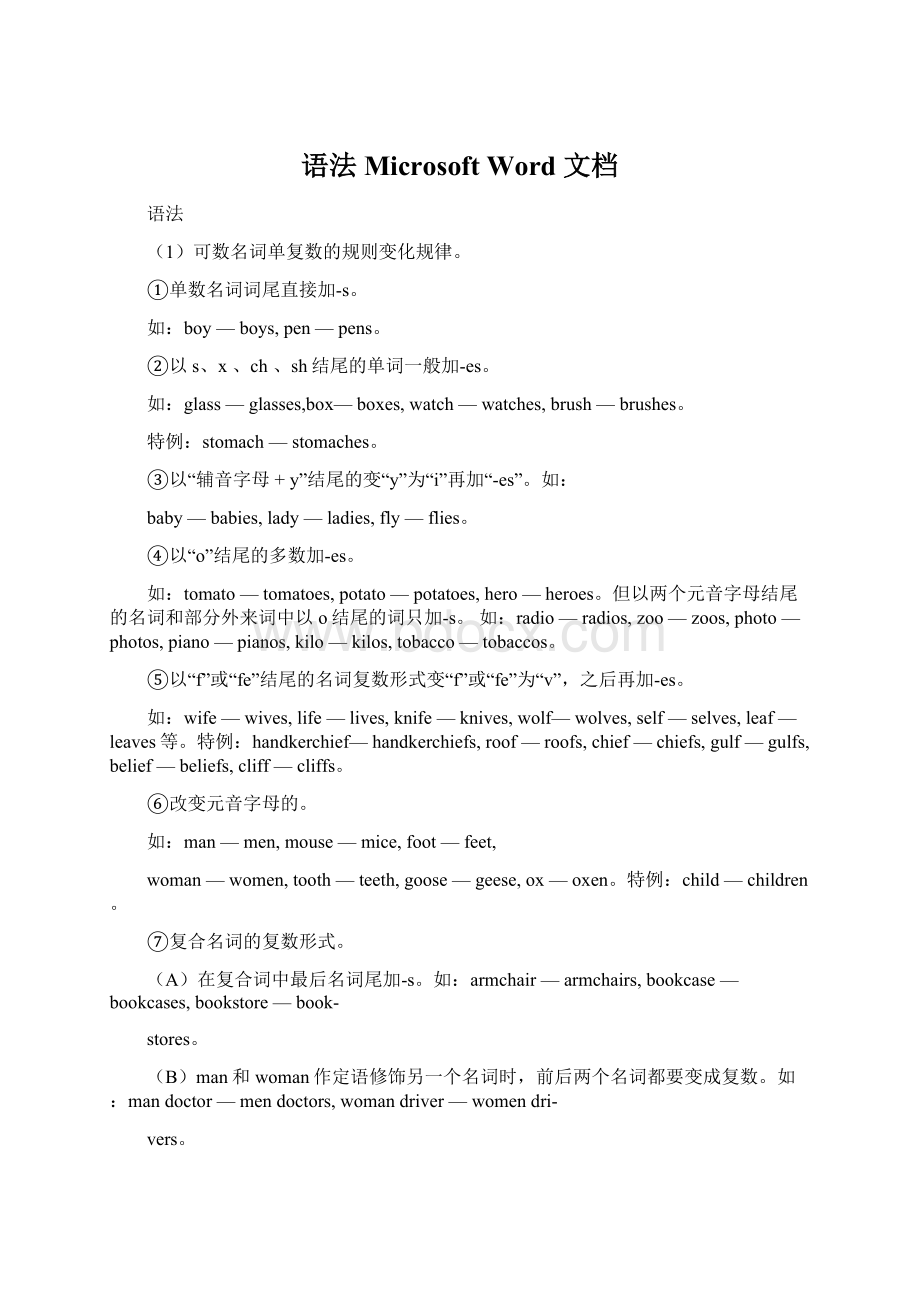语法Microsoft Word 文档.docx
《语法Microsoft Word 文档.docx》由会员分享,可在线阅读,更多相关《语法Microsoft Word 文档.docx(12页珍藏版)》请在冰豆网上搜索。

语法MicrosoftWord文档
语法
(1)可数名词单复数的规则变化规律。
①单数名词词尾直接加-s。
如:
boy—boys,pen—pens。
②以s、x、ch、sh结尾的单词一般加-es。
如:
glass—glasses,box—boxes,watch—watches,brush—brushes。
特例:
stomach—stomaches。
③以“辅音字母+y”结尾的变“y”为“i”再加“-es”。
如:
baby—babies,lady—ladies,fly—flies。
④以“o”结尾的多数加-es。
如:
tomato—tomatoes,potato—potatoes,hero—heroes。
但以两个元音字母结尾的名词和部分外来词中以o结尾的词只加-s。
如:
radio—radios,zoo—zoos,photo—photos,piano—pianos,kilo—kilos,tobacco—tobaccos。
⑤以“f”或“fe”结尾的名词复数形式变“f”或“fe”为“v”,之后再加-es。
如:
wife—wives,life—lives,knife—knives,wolf—wolves,self—selves,leaf—leaves等。
特例:
handkerchief—handkerchiefs,roof—roofs,chief—chiefs,gulf—gulfs,belief—beliefs,cliff—cliffs。
⑥改变元音字母的。
如:
man—men,mouse—mice,foot—feet,
woman—women,tooth—teeth,goose—geese,ox—oxen。
特例:
child—children。
⑦复合名词的复数形式。
(A)在复合词中最后名词尾加-s。
如:
armchair—armchairs,bookcase—bookcases,bookstore—book-
stores。
(B)man和woman作定语修饰另一个名词时,前后两个名词都要变成复数。
如:
mandoctor—mendoctors,womandriver—womendri-
vers。
(C)与介词或副词一起构成的复合名词应在主体名词部分加-s。
如:
brother-in-law—brothers-in-law,passer-by—passers-by。
⑧有的名词有两种复数形式。
如:
zero—zeros、zeroes,deer—
deers、deer。
penny的两种复数形式含义有所不同。
如:
pence(便士的钱数),pennies(便士的枚数)。
(2)可数名词单复数的不规则变化总结
①单、复数同形。
如:
means,aircraft,deer,fish,Chinese,
Japanese,sheep,works(工厂),cattle。
②合成名词的复数。
如:
boy-friend—boy-friends,go-between—go-betweens(中间人),grown-up—grown-ups。
③有些名词通常只用作复数。
如:
glasses眼镜,clothes衣服,goods
货物,trousers裤子,belongings所有物,wages工资,riches财富,surroundings环境,ashes灰尘,campasses圆规,cattle家畜,congratulations祝贺,havewordswithsb.同某人吵架,inhighspirits以很高热情地,giveone’sregardstosb.向某人问侯,inrags衣衫破烂,Itisgoodmannerstodosth.有礼貌做某事。
④集体名词的数。
有些集体名词通常只用作复数,如:
people,
cattle,police;有些名词只用作单数,如:
machinery,furniture,mankind,jewellery;有些名词既可用作单数又可用作复数,单数看做整体,复数看做集体的各个成员。
如:
Thecrewislarge.船员人数很多(指整体);Thecrewarealltired.船员们都累坏了(个体)。
本文出自:
原文链接:
一般现在时的用法
1)经常性或习惯性的动作,常与表示频度的时间状语连用。
时间状语:
every…,sometimes,at…,onSunday。
例如:
Ileavehomeforschoolat7everymorning.每天早上我七点离开家。
2)客观真理,客观存在,科学事实。
例如:
Theearthmovesaroundthesun.地球绕太阳转动。
ShanghailiesintheeastofChina.上海位于中国东部。
3)表示格言或警句。
例如:
Pridegoesbeforeafall.骄者必败。
注意:
此用法如果出现在宾语从句中,即使主句是过去时,从句谓语也要用一般现在时。
例:
Columbusprovedthattheearthisround.哥伦布证实了地球是圆的。
4)现在时刻的状态、能力、性格、个性。
例如:
Idon'twantsomuch.我不要那么多。
AnnwritesgoodEnglishbutdoesnotspeakwell.
安英语写得不错,讲的可不行。
比较:
NowIputthesugarinthecup.把糖放入杯子。
Iamdoingmyhomeworknow.我正在做功课。
第一句用一般现在时,用于操作演示或指导说明的示范性动作,表示言行的瞬间动作。
第二句中的now是进行时的标志,表示正在进行的动作的客观状况,所以后句用一般现在时。
11.2一般过去时的用法
1)在确定的过去时间里所发生的动作或存在的状态。
例如:
时间状语有:
yesterday,lastweek,anhourago,theotherday,in1982等。
例如:
Wheredidyougojustnow?
刚才你上哪儿去了?
2)表示在过去一段时间内,经常性或习惯性的动作。
例如:
WhenIwasachild,Ioftenplayedfootballinthestreet.
我是个孩子的时候,常在马路上踢足球。
WhenevertheBrownswentduringtheirvisit,theyweregivena
warmwelcome.
那时,布朗一家无论什么时候去,都受到热烈欢迎。
3)句型:
Itistimeforsb.todosth"到……时间了""该……了"。
例如:
Itis
timeforyoutogotobed.你该睡觉了。
Itistimethatsb.didsth."时间已迟了""早该……了",例如Itistimeyou
wenttobed.你早该睡觉了。
would(had)rathersb.didsth.表示'宁愿某人做某事'。
例如:
I'dratheryou
cametomorrow.还是明天来吧。
4)wish,wonder,think,hope等用过去时,作试探性的询问、请求、建议等,而一般过去时表示的动作或状态都已成为过去,现已不复存在
。
例如:
Ithoughtyoumighthavesome.我以为你想要一些。
比较:
Christinewasaninvalidallherlife.(含义:
她已不在人间。
)
Christinehasbeenaninvalidallherlife.(含义:
她现在还活着)
Mrs.DarbylivedinKentuckyforsevenyears.
(含义:
达比太太已不再住在肯塔基州。
)
Mrs.DarbyhaslivedinKentuckyforsevenyears.
(含义:
现在还住在肯塔基州,有可能指刚离去)
注意:
用过去时表示现在,表示委婉语气。
1)动词want,hope,wonder,think,intend等。
例如:
Didyouwantanythingelse?
您还要些什么吗?
Iwonderedifyoucouldhelpme.能不能帮我一下。
2)情态动词could,would。
例如:
Couldyoulendmeyourbike?
你的自行车,能借用一些吗?
11.3usedto/beusedto
usedto+do:
"过去常常"表示过去习惯性的动作或状态,但如今已不存在。
例如:
Motherusednottobesoforgetful.老妈过去没那么健忘。
Scarfusedtotakeawalk.斯卡夫过去常常散步。
beusedto+doing:
对……已感到习惯,或"习惯于",to是介词,后需加名词或动名词。
例如:
Heisusedtoavegetariandiet.
Scarfisusedtotakingawalk.斯卡夫现在已习惯于散步了。
典型例题
----Yourphonenumberagain?
I___quitecatchit.
----It's69568442.
A.didn'tB.couldn'tC.don'tD.can't
答案A.本句虽没有明确的时间状语,但从语意上看出,在听的时候没有听懂这个动作发生在过去,因此应用过去时。
11.4一般将来时
1)shall用于第一人称,常被will所代替。
will在陈述句中用于各人称,在征求意见时常用于第二人称。
例如:
WhichparagraphshallIreadfirst?
我先读哪一段呢?
Willyoubeathomeatseventhisevening?
今晚七点回家好吗?
2)begoingto+不定式,表示将来。
a.主语的意图,即将做某事。
例如:
Whatareyougoingtodotomorrow?
明天打算作什么呢?
b.计划,安排要发生的事。
例如:
Theplayisgoingtobeproducednext
month。
这出戏下月开播。
c.有迹象要发生的事。
例如:
Lookatthedarkclouds,thereisgoingtobea
storm.看那乌云,快要下雨了。
3)be+不定式表将来,按计划或正式安排将发生的事。
例如:
WearetodiscussthereportnextSaturday.我们下星期六讨论这份报告。
4)beaboutto+不定式,意为马上做某事。
例如:
HeisabouttoleaveforBeijing.他马上要去北京。
注意:
beabouttodo不能与tomorrow,nextweek等表示明确将来时的时间状语连用。
11.5begoingto/will用于条件句时,begoingto表将来,will表意愿。
例如:
Ifyouaregoingtomakeajourney,you'dbettergetreadyforitassoonaspossible.
Nowifyouwilltakeoffyourclothes,wewillfitthenewclothesonyouinfrontofthemirror.
11.6beto和begoingto
beto表示客观安排或受人指示而做某事,begoingto表示主观的打算或计划。
例如:
Iamtoplayfootballtomorrowafternoon.明天下午我去踢球。
(客观安排)
I'mgoingtoplayfootballtomorrowafternoon.
明天下午我想去踢球。
(主观安排)
11.7一般现在时表将来
1)下列动词come,go,arrive,leave,start,begin,return的一般现在时可以表示将来,主要用来表示在时间上已确定或安排好的事情。
例如:
Thetrainleavesatsixtomorrowmorning.火车明天上午六点开。
Whendoesthebusstar?
Itstarsintenminutes.汽车什么时候开?
十分钟后。
2)以here,there等开始的倒装句,表示动作正在进行。
例如:
Herecomesthebus.=Thebusiscoming.车来了。
Theregoesthebell.=Thebellisringing.铃响了。
3)在时间或条件句中。
例如:
WhenBillcomes(不是willcome),askhimtowaitforme.比尔来后,让他等我。
I'llwritetoyouassoonasIarrivethere.我到了那里,就写信给你。
4)在动词hope,takecarethat,makesurethat等的宾语从句中。
例如:
Ihopetheyhaveanicetimenextweek.我希望他们下星期玩得开心。
Makesurethatthewindowsareclosedbeforeyouleavetheroom.离开房间前,务必把窗户关了。
11.8用现在进行时表示将来
下列动词come,go,arrive,leave,start,begin,return等现在进行时可以表示将来。
例如:
I'mleavingtomorrow.明天我要走了。
Areyoustayingheretillnextweek?
你会在这儿呆到下周吗?
11.9现在完成时
现在完成时用来表示之前已发生或完成的动作或状态,其结果的影响现在还存在;也可表示持续到现在的动作或状态。
其构成:
have(has)+过去分词。
11.10比较一般过去时与现在完成时
1)一般过去时表示过去某时发生的动作或单纯叙述过去的事情,强调动作;现在完成时为过去发生的,强调过去的事情对现在的影响,强调的是影响。
2)一般过去时常与具体的时间状语连用,而现在完成时通常与模糊的时间状语连用,或无时间状语。
一般过去时的时间状语:
yesterday,lastweek,…ago,in1980,inOctober,just
now等,皆为具体的时间状语。
现在完成时的时间状语:
for,since,sofar,ever,never,just,yet,till/until,uptonow,inpastyears,always等,皆不确定的时间状语。
共同的时间状语:
thismorning,tonight,thisApril,now,already,recently,lately等。
3)现在完成时可表示持续到现在的动作或状态,动词一般是延续性的,如live,teach,learn,work,study,know.。
一般过去时常用的非持续性动词有come,go,leave,start,die,finish,become,getmarried等。
例如:
Isawthisfilmyesterday.(强调看的动作发生过了)
Ihaveseenthisfilm.(强调对现在的影响,电影的内容已经知道了)
Whydidyougetupsoearly?
(强调起床的动作已发生过了)
Whohasn'thandedinhispaper?
(强调有卷子未交,疑为不公平竞争)
HehasbeenintheLeagueforthreeyears.(在团内的状态可延续)
HehasbeenaLeaguememberforthreeyears.(是团员的状态可持续)
句子中如有过去时的时间副词(如yesterday,last,week,in1960)时,不能使用现在完成时,要用过去时。
(错)Tomhaswrittenalettertohisparentslastnight.
(对)Tomwrotealettertohisparentslastnight.
11.11用于现在完成时的句型
1)Itisthefirst/secondtime....that…结构中的从句部分,用现在完成时。
例如:
ItisthefirsttimethatIhavevisitedthecity.这是我第一次访问这城市。
Thisisthefirsttime(that)I'veheardhimsing.这是我第一次听他唱歌。
注意:
Itwasthethirdtimethattheboyhadbeenlate.
2)Thisis+形容词最高级+that…结构,that从句要用现在完成时。
例如:
ThisisthebestfilmthatI've(ever)seen.这是我看过的最好的电影。
典型例题
(1)---Doyouknowourtownatall?
---No,thisisthefirsttimeI___here.
A.wasB.havebeenC.cameD.amcoming
答案B.Thisisthefirsttime后面所加从句应为现在完成时,故选B。
(2)---Haveyou____beentoourtownbefore?
---No,it'sthefirsttimeI___here.
A.even,comeB.even,havecomeC.ever,comeD.ever,havecome
答案D.ever意为曾经或无论何时,反意词为never,此两词常用于完成时。
注意:
非延续性动词的否定形式可以与表示延续时间的状语连用。
即动作不发生的状态是可以持续的。
(错)Ihavereceivedhisletterforamonth.
(对)Ihaven'treceivedhisletterforalmostamonth.
11.12比较since和for
Since用来说明动作起始时间,for用来说明动作延续时间长度。
例如:
Ihavelivedhereformorethantwentyyears.我住在这儿二十多年了。
IhavelivedheresinceIwasborn.我从出生起就住在这儿了。
注意:
并非有for作为时间状语的句子都用现在完成时。
Iworkedhereformorethantwentyyears.(我现在已不在这里工作。
)
Ihaveworkedhereformanyyears.(现在我仍在这里工作。
)
注意:
用句型转换的方法,很容易排除非延续动词在有for/since结构的完成时中的误用。
1)(对)TomhasstudiedRussianforthreeyears.=TombegantostudyRussianthreeyearsago,andisstillstudyingitnow.
2)(错)Harryhasgotmarriedforsixyears.=Harrybegantogetmarriedsixyearsago,andisstillgettingmarriednow.
显然,第二句不对,它应改为Harrygotmarriedsixyearsago.或Harryhasbeenmarriedforsixyears.
11.13since的四种用法
1)since+过去一个时间点(如具体的年、月、日期、钟点、1980,lastmonth,halfpast
six)。
例如:
Ihavebeenheresince1989.1989起,我一直在这儿。
2)since+一段时间+ago。
例如:
Ihavebeenheresincefivemonthsago.我在这儿,已经有五个月了。
3)since+从句。
例如:
Greatchangeshavetakenplacesinceyouleft.你走后,变化可大了。
Greatchangeshavetakenplacesincewewerehere.我们走后,变化可大了。
4)Itis+一段时间+since从句。
例如:
ItistwoyearssinceIbecameapostgraduatestudent.我考上研究生有两年了。
11.14延续动词与瞬间动词
1)用于完成时的区别
延续动词表示经验、经历;瞬间动词表示行为的结果,不能与表示段的时间状语连用。
例如:
Hehascompletedthework.他已完成了那项工作。
(表结果)
I'veknownhimsincethen.我从那时起就认识他了。
(表经历)
2)用于till/until从句的差异
延续动词用于肯定句,表示"做……直到……"瞬间动词用于否定句,表示"到……,才……"。
例如:
Hedidn'tcomebackuntilteno'clock.他到10点才回来。
Hesleptuntilteno'clock.他一直睡到10点。
典型例题
1.